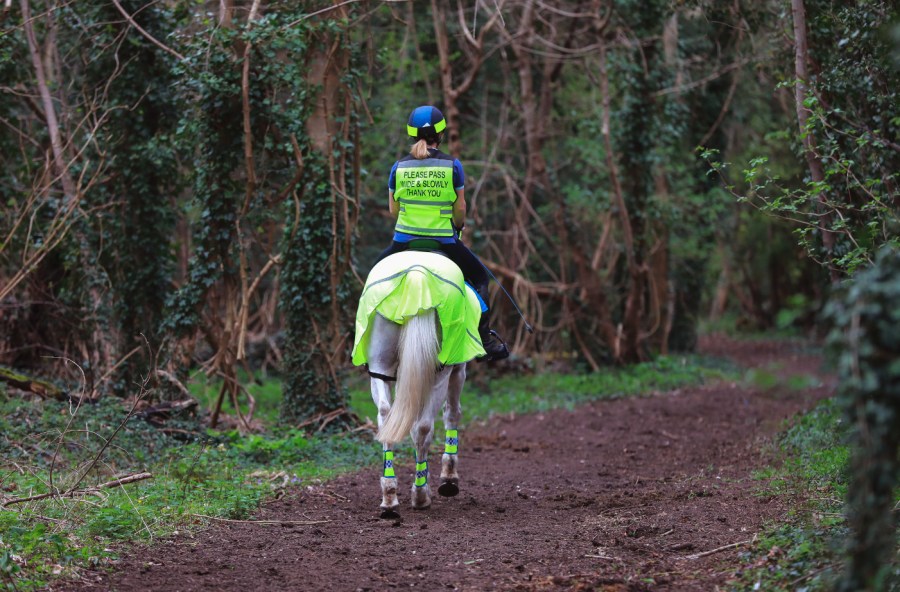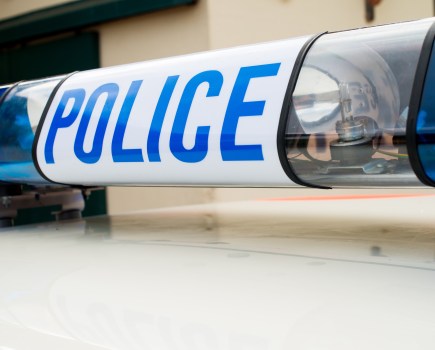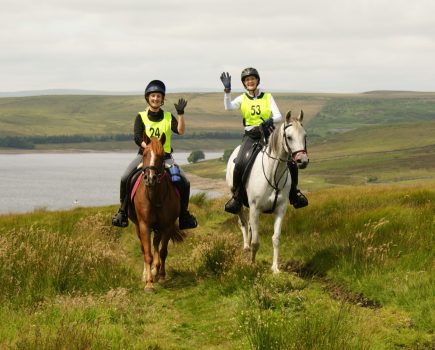In partnership with Equisafety
Spinning is daunting for many riders, and it can feel difficult to address, especially if you can’t figure out why your horse is doing this behaviour. The good news is that you’re not alone, and you can help your horse overcome this to hack more confidently. BHS instructor and horse trainer Jo Birkbeck shares her expertise on how she helps horses to stop spinning. To do this, she has a checklist to work through to identify the cause of the spinning; this always starts with ruling out pain.
Ruling out pain
“It could be internal pain or pain caused by using ill-fitting tack. The first things I check are saddle and bridle fit, and then I have their teeth and back checked,” says Jo. “Next I’d explore the likelihood of stomach ulcers. Having ulcers can make a horse more spooky and either not respond or overreact to the rider’s leg aids. I also check for foot soreness, lameness and shoulder discomfort, as this can give rise to spinning as it’s uncomfortable for them to go downhill or on uneven, stony or undulating terrain.”
If tack has been re-fitted and the route of any pain has been addressed, Jo begins riding.
“I would re-establish the aids so you know the horse understands the basics: turning, stopping and to go forward from the leg. I do this in the school or field where the horse feels safe and isn’t displaying the problem behaviour. I build the horses confidence that they’re not in pain anymore and also their acceptance of the aids,” explains Jo. “I would then test the effect of the work done so far by returning to the situation which previously caused the horse to spin.”
But what if the horse is still spinning, or a vet, saddle fitter or physio couldn’t find any causes of pain? Jo then moves on to working out what else could be causing the spinning.
Lack of understanding
“The horse needs to have a clear understanding of what you’re asking,” says Jo. “They need to respond to both leg and rein aids; you should be able to control the speed and direction of the horse including leg yield, turn on the forehand and rein back. If you’ve got those tools, then the horse has something to be obedient to.”
If not, then this can leave your horse confused and not understand what you’re asking them to do.
“It’s common that a spinning horse doesn’t easily turn in the opposite direction to the way that they have spun” shares Jo. “If your horse always spins to the right and you can’t turn them left then you’ll struggle to correct the behaviour.”
Fear
If you know that every time your horse sees a certain object, such as an umbrella or traffic, or shies at walking through puddles, then it’s likely your horse is afraid of these objects.
“You have to help them to overcome their fear of such obstacles,” says Jo. She recommends starting on the ground, again making sure you can influence the speed and direction of your horse’s feet. You should be able to lead, back your horse up and move them over, before gradually introducing the spooky object. The point of this is to create good manners and a mutual respect for space.
“Once they accept a spooky object on the ground, they are ready for ridden work. Depending on the horse, I may get a second person to ride them, whilst I stay on the ground but some horses may be confident enough without this continued ground support,” says Jo. “It’s important that the person doing this training isn’t afraid of the horse or their behaviour; the rider has to feel calm and confident so this translates to the horse. If you’re not ready then get some help or support from someone more knowledgeable and confident.”
Once the horse is confident with the spooky objects in the arena, and you can control their speed and direction around the objects, it’s time to hack out again.
“Some horses need a confident companion to start with, but don’t let them rely too much on them long term,” cautions Jo. “Allow the confident horse to go in front, and once the spinning horse is happy following, you can progress to them leading instead, and then going out alone.”
Don’t expect it to be plain sailing; if they re-start spinning, just take it back a few steps and try again.
“You want to set the horse up to succeed, so don’t jump ahead too quickly or get carried away,” advises Jo. “Maybe try a shorter ride, or go back to the arena for a session. Don’t completely avoid the situation, but just backtrack a little and then try building up slowly again.”
Rider’s fear
If you’ve had an accident or near-miss before, it may have left you worried about it happening again, and this can impact your horse.
“If you’ve fallen on the road, been bolted with or had any sort of accident it does create fear or anxiety,” says Jo. “This creates a situation where you’re not a calm, confident leader for your horse and can lead to an increase in their anxiety and subsequently spinning.”
It’s important to be honest with yourself if you are in this situation. When helping riders with this problem, Jo likes to discuss whether the issue is a real fear and likely to happen, or if it’s anxiety from a previous, unrelated event.
“Some riders have anxiety from an historic event, so what they’re frightened of isn’t actually going to happen again,” says Jo. “For this rider, it’s working to show them that what happened before won’t happen again.
“In comparison, I think fear is being frightened of something that is highly likely to happen,” says Jo. This could be that your horse has spun at the same point on a hack a few times, and maybe you’ve fallen off once or twice, so you know it could happen again.
“It’s important to help the rider gain confidence and the ability to deal with the spinning, and to give the horse support/training to stop the behaviour. Sometimes I would keep the horse and rider together to work through this, but other times it’s necessary to separate them, build confidence for both and then bring them back together if the situation is suitable.”
Rider’s ability
Whether you’ve been riding for months or years, there’s always more to learn. And if you’ve never had a horse spin before, it can be difficult to know how to handle it. Sometimes it’s necessary to ask another rider to hop on – whether that’s an experienced friend who knows the horse or a professional – to see if that makes a difference to the horse’s behaviour.
“By the point someone has come to me for help, they usually have some information on whether the horse only spins with them, or if they do it with every rider who’s tried. If it’s not too dangerous for them and they feel safe enough, then I’ll ask them to show me the spinning problem so I can make an assessment,” explains Jo. “Usually, I’ll move them into a safe environment – off the roads – and teach the rider how to deal with their horse’s reaction, so they have the skillset they need.
“If it’s more fundamental – such as the rider easily loses their balance and therefore control – we’d do a training programme, possibly on another horse, to improve their stability and security in the saddle.”
Not every rider wants to go back to riding a horse that spins, even if the behaviour has been addressed by a professional – and that’s ok.
“Sometimes a rider has been over-horsed, or they just don’t want to deal with the problem and they want permission to not have to continue,” shares Jo. “At times the equestrian industry’s culture of ‘never give up’ is unhelpful and can encourage people to put themselves in unnecessary danger.
“There’s nothing wrong with finding the horse a suitable different home, and then finding a better-suited horse for the rider, so longs as it’s the best outcome for both horse and human.”
Separation anxiety
Whilst your horse may be spinning to get away from something they’re scared of, equally they could be spinning to get back towards their friends.
“If your horse is fearful of something, they generally won’t spin until they see that thing. If it’s separation anxiety then it might be as soon as you try to leave the yard. Their adrenaline will come up, they may neigh, back up and possibly try to turn around a few times which if successful, can then lead into spinning,” explains Jo. “If the root cause of the spinning is separation anxiety then the spinning is more of a situation behaviour rather than a reaction to a specific stimulus or pain.”
This can be one of the most difficult causes of spinning to deal with, but it is possible with time, patience and confidence.
“It’s very important that the person handling the horse isn’t afraid of the behaviour,” highlights Jo. “If separation anxiety is strong, the horse can lose his ability to listen as he’s focused on getting back to the herd, which can make them very difficult to handle. So the person handling them must be able to cope with this and stay safe.”
Jo suggests looking at the horse’s living arrangements first and foremost – does your horse spend all their time with their best friend? Could you move them to a different herd or separate them before a ride so they don’t see each other as you leave the yard?
Next, it’s about taking incremental steps so your horse becomes accustomed to being away from their friend. Taking them on very short walks, even without leaving the yard to start with, as well as improving your relationship and bond so your horse looks to you in times of stress. But it can take a very long time to truly overcome and you may encounter setbacks.
“Separation anxiety can be worse due to hormones, triggered by seeing a horse that’s similar to their best friend or triggered by fear. For example, you’ve solved the separation anxiety coming out the yard but something spooks the horse later on the hack, and they want to be back to the herd for safety,” says Jo. “If this is what you’re dealing with, you’ll want to make sure your horse is very responsive to your aids and has good ground manners. Keep their brain busy and focused during training to distract them from their separation anxiety. You could also try hacking out with other horses who aren’t their best friend, perhaps even from another yard if possible. It can be necessary and very helpful, to change their herd situation.”
Is spinning spooking or napping?
Is there a difference, and does it matter?
“I would classify them depending on the situation the horse is in when they do the behaviour,” says Jo. “Let’s say you’re at a cross country clinic with a group of other riders. If your horse spins away from a fence with bright colours, then that is from fear of the object so you’d need to address this with confidence training.
“But if it’s your turn to go and your horse spins to get back to the ride then that’s not spooking, it’s separation anxiety or napping. Here, it would be important to help the rider be more in control and improve their relationship.
“The training crosses over for both, but with spooking you deal with the fear first, whereas napping you deal with the behaviour.”
Jo feels it is imperative to use a fair, definitely non-violent, patient, firm but kind approach to develop the best relationship with your horse.
Meet the expert: Jo Birkbeck is a BHSII instructor and horse trainer based on the South Cumbria and North Lancashire border. She is a Monty Roberts Certified Instructor (MRCI) and accredited classical dressage coach by Silvia Loch, and is currently training to be a human psychotherapist. Visit her website here.
This content is brought to you in partnership with Equisafety, the performance equine reflective clothing brand and proud supporter of #Hack1000Miles.








